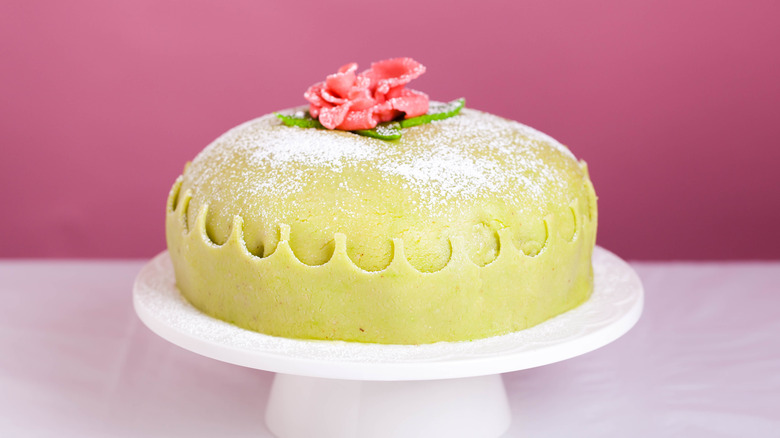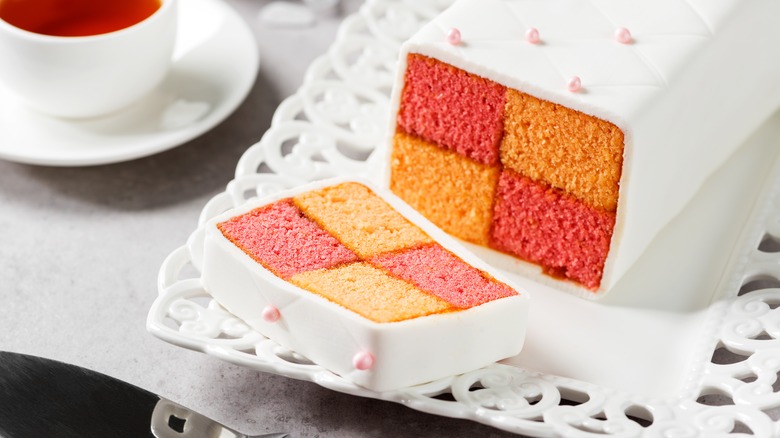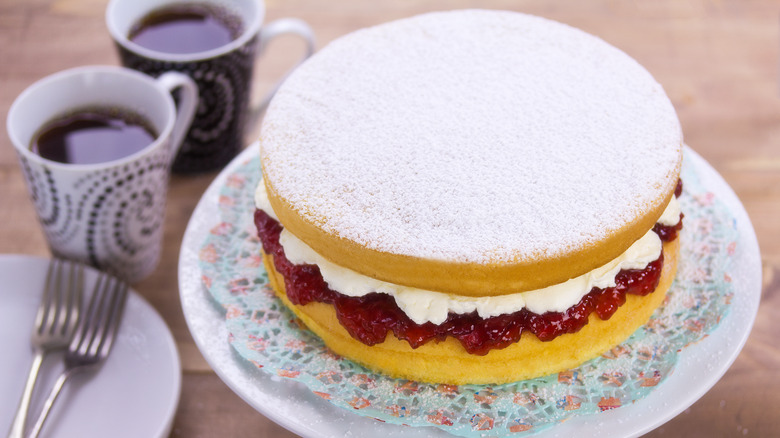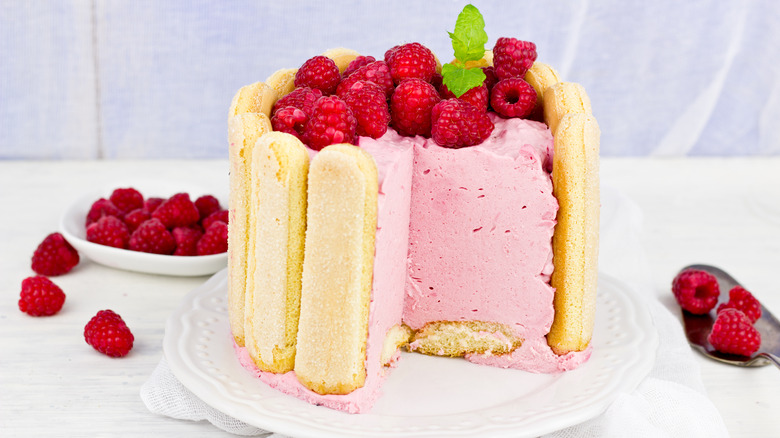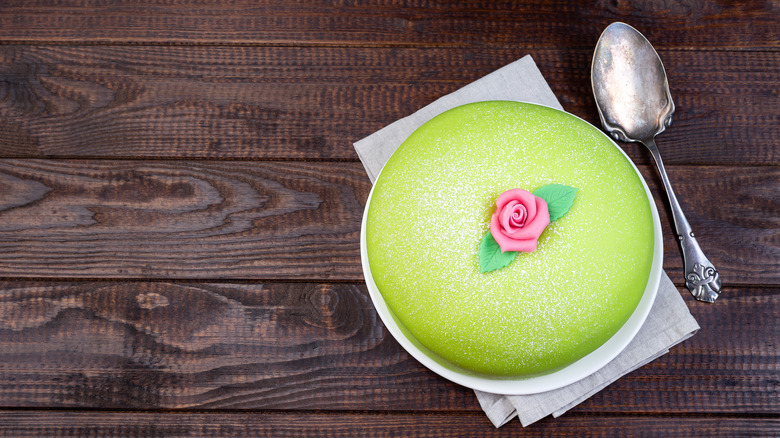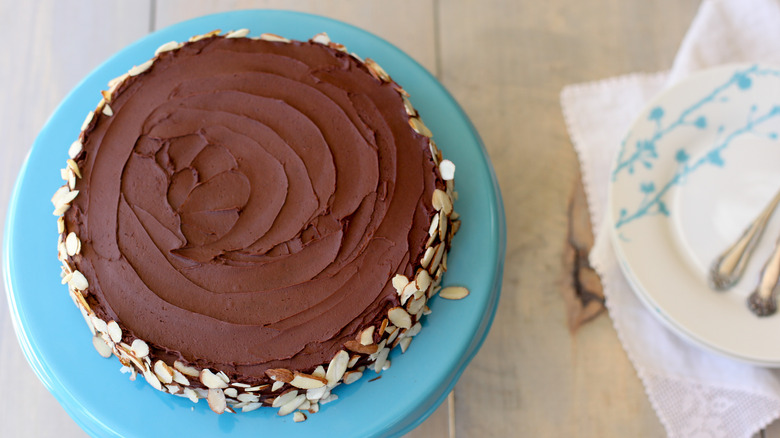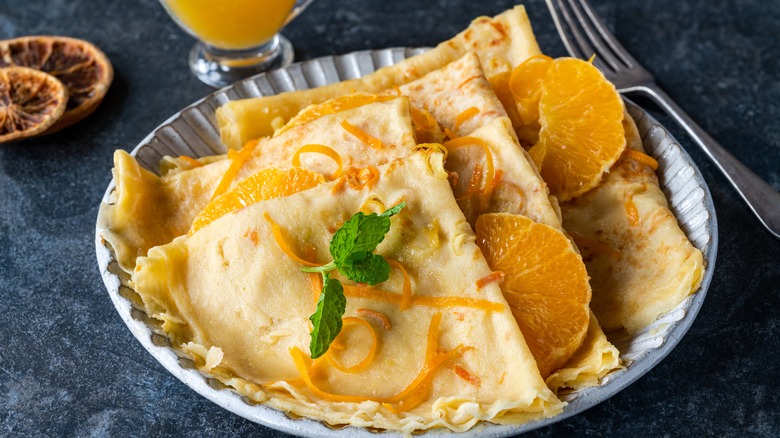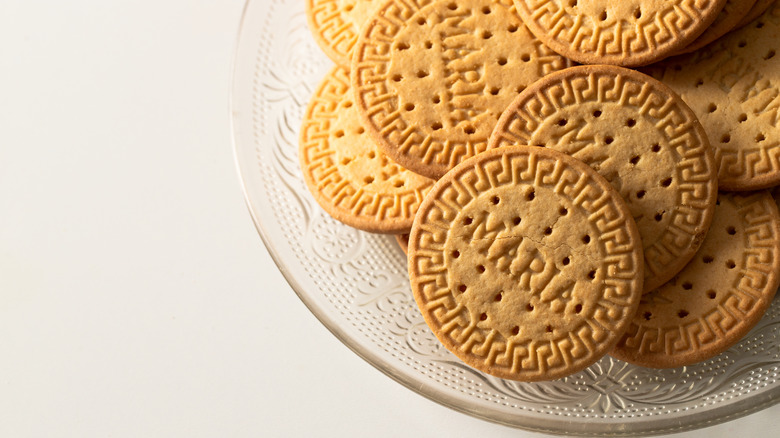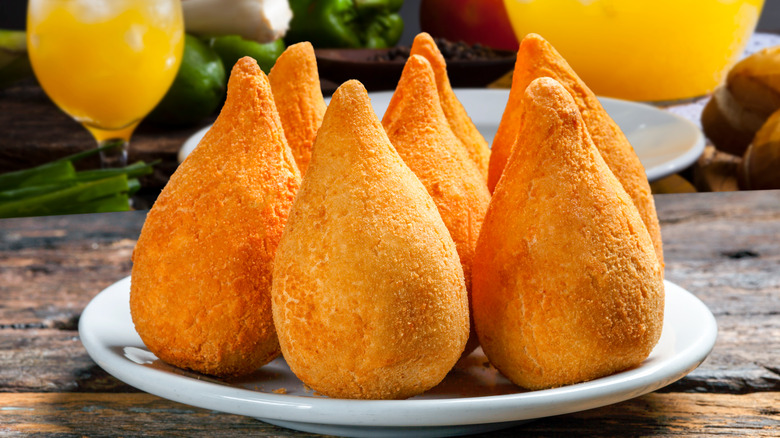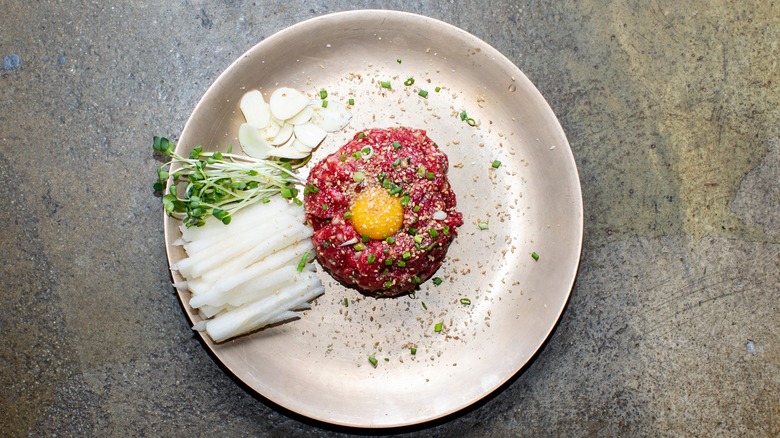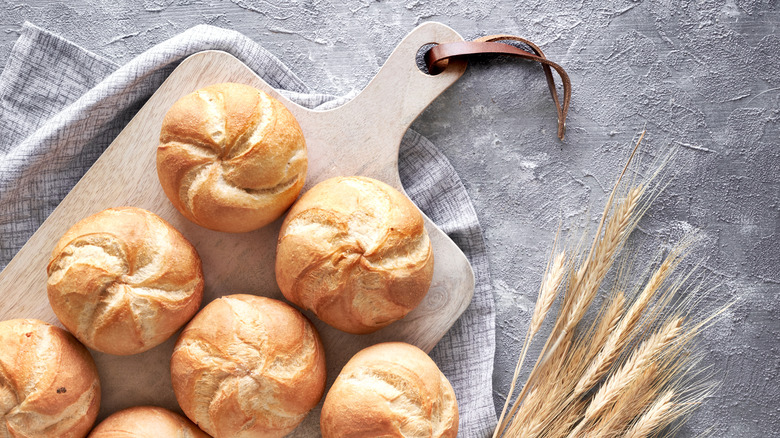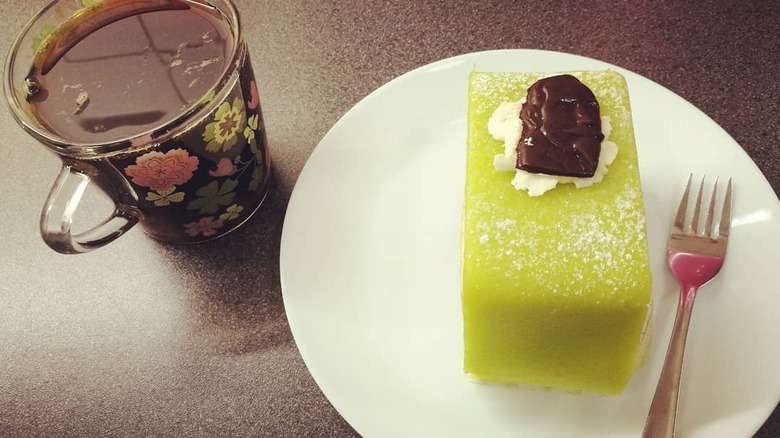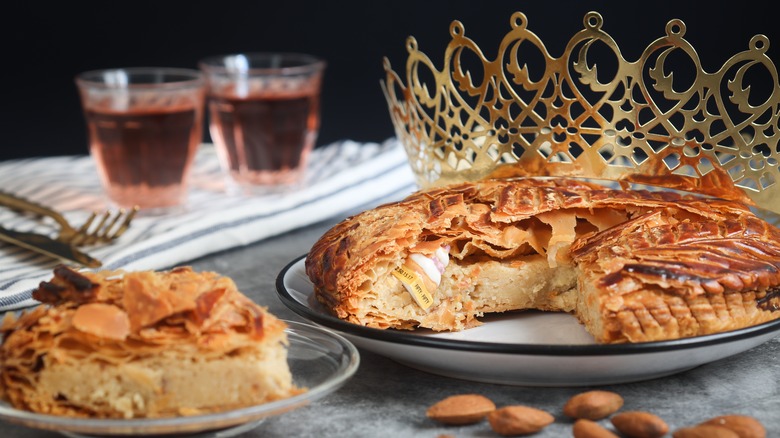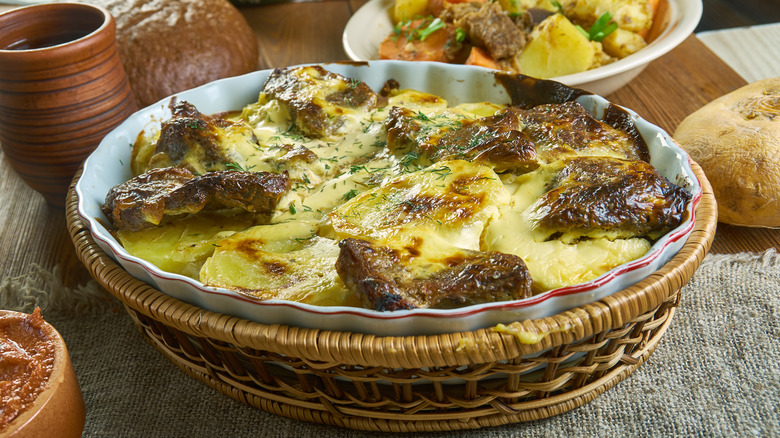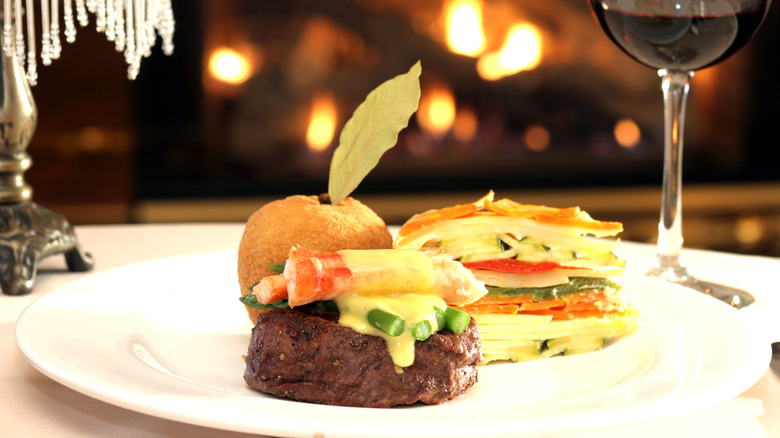14 Dishes That Were Inspired By Royalty
The culinary world has a long history of drawing inspiration for dishes from kings, queens, emperors, and various members of the nobility — after all, they were the ones who could afford fancy feasts. Chefs have created many luxurious cakes, elaborate pastries, decadent sauces, and rich stews that bear a royal namesake. After so many years of imbuing royal attributions to food, it can still be surprising to learn how many popular dishes like the classic Margherita pizza and the humble sandwich, now considered commonplace, carry an unexpectedly imperial lineage.
Perhaps the most prolific royal presence in the food world, members of the British royal family have lent their monikers to dozens of dishes over the centuries from now quintessential British pastries and teas to savory salads and beloved brunch cocktails. Prince Albert even has a variety of apple that carries his name. In fact, new dishes are still being created in honor of royalty, such as the Platinum Jubilee Pudding created by Jemma Melvin in 2022 to celebrate the 70th anniversary of the late Queen Elizabeth II's ascension to the throne (via Today).
Whether in celebration or to appease the whims of a ruler, chefs around the world have created a bountiful banquet of sweet and savory dishes. Thankfully, you don't have to be a royal to enjoy the following aristocratic eats.
1. Battenberg cake
Many of the cakes, pastries, and puddings found in British bakeries or challenging contestants on the Great British Bake Off can be traced back to the royal family. Widely enjoyed in modern Britain, often alongside afternoon tea, Battenberg cake is a colorful creation made with four square logs of sponge arranged in a checkerboard pattern, glued together with a layer of fruit jam, and wrapped in a marzipan coating.
Traditional lore claims the Battenberg cake was created to mark the wedding of Queen Victoria's granddaughter, Princess Victoria of Hesse, to Louis of Battenberg in 1884. However, according to the University of Southampton, the first known recipe for this cake was in "Saleable Shop Goods," an 1898 book written by pastry cook, Frederick Vine, over a decade after the Battenberg wedding. Vine's version only loosely resembled what we now recognize as a Battenberg cake with nine sections alternating red and white and wrapped in a layer of almond paste.
During the late 19th century, several similar cakes appeared under different names such as the Neapolitan roll, the gateau à la domino, or church window cake. While theories abound as to the four-paneled version of this classic cake, such as representing Prince Louis and his three brothers, the choice may have been a logistical one, as this simpler version began mass production in the 1920s with the Battenberg name attached to give the cake some sophisticated flair.
2. Victoria sponge
Among the many dishes named in honor of Queen Victoria, the monarch's notorious sweet tooth has led to her association with numerous desserts, including the quintessential tea-time treat Victoria sponge (via English Heritage). The Victorian era established socializing at afternoon tea as an essential facet of British life for the upper class with the honored beverage served alongside an array of petite sandwiches, cakes, and sweets. Said to be the Queen's favorite, Victoria sponge consists of airy cake layers sandwiched together with whipped cream (or buttercream) and jam and dusted with caster sugar.
According to Grant's Bakery, sponge cakes can be traced back to around the 15th century, with versions of this light, open-crumbed cake appearing all across the globe. The sweet, simple sponge that now carries Victoria's name has endured as a classic treat along with innovations from this era that revolutionized the art of baking and the tea experience, including Alfred Bird's invention of baking powder and Earl Grey tea.
3. Charlotte Russe
With numerous styles of the elegant, molded French dessert, Charlotte cakes actually comprise their own category of sweet treats, according to Masterclass. While some are baked, others are chilled until set and served cold. The origin of the name is disputed, but many believe the Charlotte Russe cake, the predecessor of the Charlotte Royale and other elegant cakes, takes its name from Queen Charlotte, the sister-in-law of Czar Alexander I (hence "russe," which means Russian in French) and the wife of King George III of Great Britain (via What's Cooking America). A late 18th-century version of the Charlotte cake featured thick apple compote baked into a mold lined with buttered bread as a way to use stale pieces and leftovers and was known as an apple Charlotte.
The elegant Charlotte Russe brought the style into popularity. It was an invention of French chef Marie Antoine Careme, who worked for Russian and British royal families. A Charlotte Russe features Bavarian cream filling lined with ladyfingers and finished with maraschino cherries or berries. As described in Politico, miniature versions of the Charlotte Russe were eventually wrapped in cardboard tubes and served in New York City sweet shops, enthralling locals with their accessible indulgence.
This classic royal-inspired dessert got a modern upgrade from TV presenter and food critic Madam Mercotte, who made the Charlotte Royale: a show-stopping, domed variation of the Charlotte-style cake finished with swirled rounds cut from a Swiss roll and filled with luscious Bavarian cream.
4. Princess Cake
British royals aren't the only ones to lend their names to decadent desserts. Swedish Princess cake, or princesstårta, is an elegant treat created by a Swedish home economics teacher named Jenny Åkerström in the early 20th century (via Swedish Food). Åkerström was an instructor to the three Swedish princesses: Margaretha, Martha, and Astrid, daughters of Prince Carl, the brother of King Gustaf V. She published a series of cookbooks with the 1929 version featuring the princesses' portraits on the cover. In the 1948 version can be found a recipe for grön tårta, perhaps the origin of the cake's signature green color. The name was reportedly changed to princesstårta because it was so beloved by the princesses.
Legend has it that Åkerström actually created three elaborately decorated cakes, one for each princess. While some say the princess cake is an amalgamation of the three, Astrid's cake most closely resembles the modern version of the beloved confection and the 1948 grön tårta. Modern Princess cake is typically shaped in a dome with 8 or more layers of sponge, jam, and custard covered in a layer of green marzipan and finished with decorative pink fondant or marzipan roses. According to Visit Stockholm, Princess cakes are a timeless classic for birthday parties, festive celebrations, and monumental occasions across the nation.
5. Queen of Sheba cake
The French are especially notorious for distinguishing dishes by attaching an evocative moniker inspired by royalty, artists, and other famous personalities. The patisseries of France offer decadent and elaborate cakes and desserts, including the chocolate Queen of Sheba cake, which is laden with generous amounts of butter and nuts.
Britannica recounts the Biblical story of the Queen of Sheba, ruler of a kingdom in southwestern Arabia who visited the court of King Solomon at the head of a caravan bearing jewels, spices, and other riches with the purpose of testing Solomon's wisdom by challenging him to solve a series of riddles. Known as Bilqīs in Arabic, she is also an important figure in Islamic tradition and the subject of numerous legends. Called Makeda, the Queen of Sheba is a central aspect of the foundational story of Ethiopia as well and believed to be the genesis of the nation's Solomonic dynasty, which ruled until 1974.
Imaginative French chefs dreamed of dark, rich, and opulent desserts inspired by this mythical figure. Unlike other French cakes, the Reine de Saba, or Queen of Sheba cake, should be moist and baked for a relatively short time with no need for filling (via Washington Post). While many versions exist of this queen's cake, the most distinctive is finished with a glossy chocolate glaze and shaved almonds adorning its edges.
6. Crêpes Suzette
Crêpes Suzette is a classic dish consisting of thin pancakes flambeéd in a mixture of Cointreau, Grand Marnier, and brandy with a bright and sweet orange butter sauce. The origins of the dessert can be traced back to 1895, when famed French chef Henri Charpentier (then only 16 years of age) was a preparing a meal for the Prince of Wales, son of Queen Victoria.
"Among the diners at the table was a beautiful French girl named Suzette," Charpentier recalled (via The New York Times). While preparing an order of crêpes, the chef's improvisation with the brandy sauce resulted in an unexpected burst of flames that turned out to be a happy accident as the Prince was delighted with the results. "I was thrilled and offered to name them in his honor but he declined," noted Charpentier. "'Henri,' he said. 'We must always remember that the ladies come first. We will call this glorious thing crêpes Suzette.'" The flashy dessert remains a staple at French restaurants, as the tableside theatrics continue to wow diners.
7. Marie biscuits
Created in London in 1874 to commemorate the wedding of Maria Alexandrovna, Russia's Grand Duchess, to Queen Victoria's second son, the Duke of Edinburgh, the Marie biscuit has made its way into hearts and pantries all over the world. In the late 19th century, sweet biscuits, called fancies, were only produced locally and on a small scale (via India Times). Biscuits referred to the hard, plain rations meant to last on lengthy voyages by ship. New technologies such as airtight containers allowed snacks to be transported farther, and as the British empire spread, so did their penchant for biscuit breaks. According to Biscuit People, the Marie biscuit, originally known as Maria, became popular throughout Europe, especially in Spain, where it is thought to have symbolized economic recovery after the country's civil war.
The simplicity of the Marie biscuit has made it a global success, finding appeal from India to Mexico. Stamped with its signature design, the lightly sweetened biscuits are a perfect complement to tea or coffee. Versatile Marie biscuits can be enjoyed with either sweet or savory accompaniments such as jams or cheeses and make an excellent textural addition to cakes and puddings.
8. Coxinha
Served in the shape of a chicken drumstick, coxinha is a popular Brazilian fried snack enjoyed at parties, weddings, and buffets (via Vida Boa Acai). While some claim the dish has French roots, and that may be so, legend has it that the dish was created to appease a young prince. The story says Prince Antonio, son of Isabel, Princess Imperial of Brazil, loved to eat chicken drumsticks, but one day, the cook ran out. To please the little prince, the cook transformed a whole chicken into the shape of a drumstick made of dough and chicken pieces, creating the beloved snack (via Nobility). The prince approved of the snack and it became so famous that upon visiting, Empress Teresa Cristina sampled the dish and brought the recipe to the Imperial Court, where it then spread across the country.
Coxinha is made in two parts, the pastry and the filling. Similar to croquettes, this savory appetizer is sometimes filled with additions like catupiry, a soft local cheese, before being coated and deep fried. Coxinha is typically eaten dipped in a Brazilian vinaigrette, hot sauce, or ketchup.
9. Yukhoe
Beef tartare — or variations of the raw beef dish such as dulet, an Ethiopian delicacy — is enjoyed in many countries around the world. Yukhoe is a classic Korean raw beef dish enhanced with seasonings of soy sauce, sesame seeds, ginger, garlic, gochujang chili paste, pine nut powder, and pears, traditionally topped with a rich, golden egg yolk. Distinctly Korean in origin, yukhoe appeared during the 17th century and was commonly referenced in the culinary literature of the Joseon Dynasty.
Yukhoe, however, was not available to everyone. During this time, cows were forbidden to kill for anyone outside of the royal family, who enjoyed this luxurious dish on special occasions and at royal banquets (via Michelin). Until the early 20th century, beef butchery was monitored by the government before factories and beef markets were later established in the regions around Seoul and Jinju, where yukhoe became part of the local cuisine.
10. Kaiser rolls
To many, it might seem that a simple, crusty bread roll would be far more likely to come from humble beginnings than imperial origins. The Kaiser roll, however, carries a rich and fascinating history rooted in the Austrian Empire. Often served alongside hearty soups or as a bun for sloppy joes, beef on weck, hamburgers, and other classic sandwiches, the Kaiser roll — also known as a hard roll, kaisersimmel, imperial roll, or Vienna roll — is a basic bread made from flour, yeast, salt, sugar, and butter. Its top is traditionally carved into five segments to resemble a star-shaped crown. The rolls are sometimes garnished with poppy seeds or sesame seeds for presentation, flavor, and texture.
Although their exact origin is hard to trace, the classic buns are believed to be named in honor of Kaiser Franz Joseph I, who reigned for nearly 70 years from 1848 to 1916 and enjoyed the rolls for breakfast. He was considered a hero of the Eastern European Jewish population for granting equal rights to Jews in the country.
11. Gustavus Adolphus pastry
On November 6 of each year, Sweden honors the memory of King Gustavus Adolphus. Every year on the day of his death, the 17th-century monarch is remembered by flying the national flag and enjoying distinctive pastries adorned with an edible likeness of the king. In a commemoration address by Gustavus Adolphus College, the king is noted as one of the most important Swedish monarchs in history due to his influence in expanding the Swedish empire, bringing Sweden into the Thirty Years' War, and expanding the national educational system. Killed in 1632 in the Battle of Lützen, the young king had been poised to become a major European power, having advanced to the throne at just 16 (via Nordstjernan).
While Swedish scholars recognize the complexities of the man, his contributions to the nation continue to be acknowledged and celebrated centuries later. Created in 1909 by pastry chef Carl Bräutigam in Gothenburg, who was inspired by the German practice of celebrating saints with special pastries, the iconic "Gustav Adolfsbakelsen" is sold only on November 6 in Sweden. Though the pastry's ingredients vary, the original reportedly had a silhouette of the king in pink marzipan on top of a pastry flavored with chocolate and lemon.
12. Frangipane
Frangipane, or frangipani, is a traditional addition to classic pastries and cakes such as the Bakewell tart. The sweet, almond-flavored custard is made by combining two parts of almond cream with one part pastry cream and is used in a variety of ways in the pastry arts. On Epiphany in France, the holiday is celebrated with a king cake, known as galette de rois, a round, frangipane-filled pastry decorated with a crown and sometimes stars or flowers with a special bean hidden inside. Whoever finds the bean is crowned king or queen for the year (via My Parisian Kitchen).
Frangipane is believed to take its name from an Italian nobleman named Marquis Muzio Frangipani, whose family served as perfumers to King Louis XIII. He introduced a bitter almond-scented perfume that became immensely popular among noblemen and royals, according to Bakepedia. The perfume was especially lauded for covering the unpleasant smell of leather gloves. French pastry chefs were so inspired by the trendy aroma that they incorporated the fragrance into pastry cream, creating the classic almond filling.
13. Veal Prince Orloff
It is somewhat ironic that one of the most enduring veal dishes takes its name from a notoriously veal-hating Russian royal. The abundantly sauced and seasoned dish, veal Orloff, sometimes spelled Orlov, is attributed to Urbain Dubois, a highly-regarded French chef of the 19th century employed by Prince Nikolai Alexeivich Orlov, who had been a Russian ambassador to France (via American History). Similar dishes known as French-style meat have been popularized in Russia, generally utilizing cheaper cuts of meat layered with mayonnaise and sliced potatoes.
Immortalized into the American culinary vernacular by Julia Child in "Mastering the Art of French Cooking, Volume I," the princely dish consists of thinly sliced braised veal, a decadent soubise, creamy duxelles, and rich Mornay sauce. In addition to being highlighted by the iconic Julia Child, a mention by Betty White in a classic episode of The Mary Tyler Moore Show helped transform veal Orloff from a French-inspired Russian dish to a dinner party classic.
14. Steak Oscar
Like many dishes named after royalty, steak Oscar is renowned for its opulence. Originally veal Oscar, sometimes spelled Oskar, named after King Oscar II of Sweden and Norway, Oscar-style steak showcases the notorious decadence of the royal gourmand. Given the king's reputation for late-night dining, a chef combined an array of his favorite indulgences, including veal, crayfish, bearnaise sauce, and blanched white asparagus spears to create the luxurious dish (via Orlando Sentinel). Modern versions of the dish are often served over steak rather than veal with lump crab or lobster meat instead of crayfish.
Although the ingredients have changed slightly, Oscar-style still refers to one of the richest and most lavish ways to serve a filet mignon or prime cut of steak. Each ingredient adds to its grandiosity, from the best cuts of meat and fresh seafood to the rich, notoriously finicky butter sauce and prized spears of white asparagus (via The Austin Artisan).
